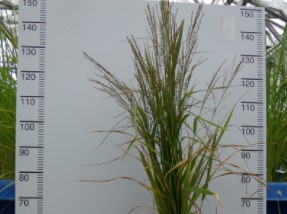By Adityarup "Rup" Chakravorty
Rice is one of the most important global cereal crops. More than half of the world’s population depend on rice as their primary source of energy from food.
Rice is cultivated around the world. But rice farmers face many challenges. These range from adapting to the effects of climate change to dealing with pressure to increase crop productivity.

The rice accessions in the USDA National Small Grains Collection have diverse panicle and grain types. Six diverse grain types with a range of bran colors are shown here.
That’s where gene banks come in. They serve as repositories for crop genetic materials.
“Gene banks preserve and characterize crop diversity for use in crop improvement, both now and for generations to come,” says Georgia Eizenga, a member of the American Society of Agronomy and Crop Science Society of America.
Eizenga is the lead author of a new study that aims to enhance the management and utility of the USDA’s repository of rice genetic resources. The research was published in Crop Science, a publication of the Crop Science Society of America.
The United States Department of Agriculture (USDA) National Small Grains Collection contains material from close to 20,000 varieties of rice. This diverse collection is especially important to the U.S. rice industry.
“Rice was introduced into the United States from Asia and Africa,” says Eizenga. “Having a diverse global collection of rice cultivars provides a source of new traits which can be used for crop improvement.”

The rice cultivar, Genekoi, is an African rice from southern Sierra Leone. Genekoi seed has red bran and is included in the USDA National Small Grains Collection.
But cataloging this collection of genetic material is no easy feat. Challenges include developing detailed descriptions, finding and correcting labelling errors, and removing redundant varieties.
Using physical characteristics to catalog close to 20,000 varieties is very difficult. Some characteristics, such as cooking quality and disease resistance, can be especially challenging to determine. That’s where genetic techniques can be useful.
“The USDA rice gene bank is a resource that has been developed over decades,” says Eizenga. “Molecular techniques will allow us to use this resource even more effectively.”
Eizenga and colleagues developed a small panel of genetic markers. Genetic markers are short, identifiable DNA sequences found in specific places of a genome.
These genetic markers serve as a guide to help researchers determine quickly whether a particular variety of rice has a specific trait. This made it easier to search the USDA rice collection and manage it more efficiently.
Take for example, resistance to fungal diseases. Without genetic markers, breeders would start by growing several different rice varieties. Then they would have to expose the rice plants to the fungus. Finally, they would observe which varieties contracted the disease and which were resistant.
Click here to see more...